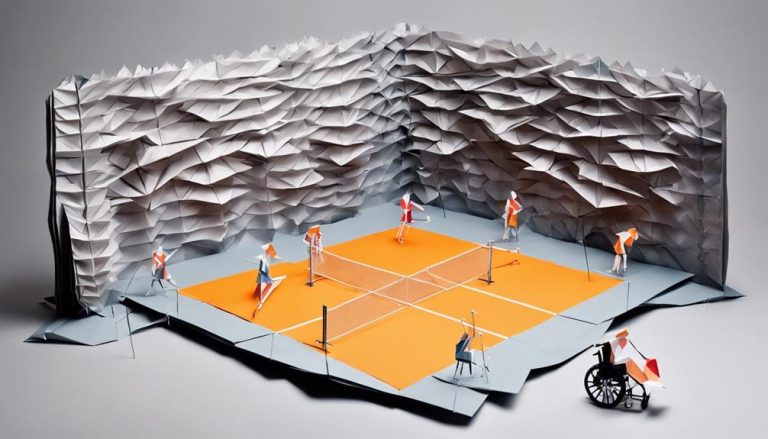General Rules of Sprint Car Racing
When stepping into the world of sprint car racing, safety should be your steadfast companion. From the mandatory safety equipment to the precise specifications of the racing machines, there's a myriad of rules that govern this high-speed sport. But, did you know that beyond the technicalities lies a realm where driver conduct and track etiquette play pivotal roles? Grab your helmet, buckle up, and get ready to explore the uncharted territories of sprint car racing rules that not only shape the competition but also define the essence of this adrenaline-fueled sport.
Safety Equipment Requirements
To race in a sprint car event, you must ensure you are equipped with all the necessary safety gear to protect yourself on the track. Helmet requirements are of utmost importance; your helmet needs to meet specific safety standards to shield your head from potential impacts. Additionally, safety harnesses play a vital role in keeping you secure within the car, preventing excessive movement during high-speed races.
Fire suits are not just for show; they are a crucial element in sprint car racing. These suits are designed to shield your body from flames in case of a fire-related incident on the track. Seat belts are another non-negotiable safety feature. They keep you firmly in place, reducing the risk of injury in the event of a sudden stop or collision.
Race Procedures and Formats
Alright, let's talk about the heart of sprint car racing – the race start procedures and heat race formats. These points are crucial in determining the outcome of the race and can make or break a driver's chances of victory. Understanding these procedures and formats is essential for every sprint car racer aiming for success on the track.
Race Start Procedures
How do sprint car races kick off with electrifying intensity and precision at the starting line? The starting positions are crucial, with drivers earning them based on qualifying times or heat race finishes. As the engines rev, the flagger takes their position, ready to signal the start of the race. It's essential for drivers to gauge the track conditions, adjusting tire pressure to optimize traction for the launch. The moment the green flag waves, it's a full-throttle dash towards the first turn, with each driver jockeying for position in the tight pack. The race start sets the tone for the entire event, requiring skill, focus, and a hunger for victory. So, when the flag drops, you push the limits and chase that adrenaline rush down the straightaway.
Heat Race Formats
As the intense sprint car race start sets the adrenaline pumping, the focus shifts to the structured and electrifying Heat Race Formats that determine the grid for the main event. When it comes to Heat Race Formats, understanding the track conditions and devising a solid heat race strategy are crucial for success on the track. The strategy you employ in these shorter races can greatly impact your starting position in the main event. Adjusting your driving style to match the track conditions will give you an edge over the competition. Being aware of how the track changes throughout the heat races and adapting your approach accordingly can make all the difference in where you place on the starting grid for the final race.
| Heat Race Formats | Importance | Tips for Success |
|---|---|---|
| Track Conditions | Understand the surface | Adapt your driving style to match |
| Heat Race Strategy | Develop a plan early | Stay focused and execute your strategy |
Car Specifications and Modifications
When it comes to sprint car racing, understanding the car specifications and modifications is crucial for both performance and safety on the track. Engine upgrades and suspension adjustments can significantly impact how your car handles corners and accelerates down straightaways. Ensuring your engine is finely tuned and your suspension is dialed in can give you the edge you need to outperform your competitors.
Moreover, paying attention to weight distribution and tire selection is paramount. Proper weight distribution can enhance stability and traction, while choosing the right tires for the track conditions can make all the difference in your lap times. Balancing these elements can lead to a more responsive and agile race car.
Driver Conduct and Sportsmanship
When you step onto the track, remember that fair play and respectful competition are not just guidelines but the essence of sprint car racing. Upholding these principles ensures a level playing field and fosters camaraderie among drivers. Embrace the challenge of racing with integrity and let sportsmanship be your driving force.
Fair Play
In the world of sprint car racing, upholding fair play standards in driver conduct and sportsmanship is paramount to the integrity and thrill of the sport. Sportsmanship is the cornerstone of racing ethics, emphasizing respect, honesty, and camaraderie among competitors. It is not just about winning; it's about how you play the game. When drivers exhibit sportsmanship on the track, it elevates the level of competition and creates a positive environment for all involved. Fair play ensures that every racer has an equal opportunity to showcase their skills and compete fairly. By embracing the values of sportsmanship and fair competition, drivers contribute to the overall excitement and honor of sprint car racing.
Respectful Competition
Embracing respectful competition in sprint car racing is essential for maintaining the integrity and spirit of the sport, fostering camaraderie among drivers, and upholding the highest standards of sportsmanship.
When engaging in respectful competition, remember these key points:
- Sportsmanship: Always show respect for your fellow competitors, both on and off the track. Treat others as you would like to be treated.
- Rivalry: Healthy competition is exciting and drives improvement, but it should never overshadow respect for your opponents. Use rivalry to push each other to be better while maintaining mutual respect.
- Fair Play: Play by the rules, and honor the sport by competing with integrity. Winning should come from skill and strategy, not shortcuts or unsportsmanlike conduct.
Track Regulations and Etiquette
As you navigate the track during a sprint car race, it is crucial to adhere to specific regulations and etiquette to ensure a safe and competitive environment for all drivers involved. Pay close attention to track conditions; factors like moisture levels, rough patches, or changes in surface grip can significantly impact your performance. Understanding flag signals is equally important. These signals communicate vital information about track conditions, warn of potential hazards, or indicate changes in the race. Responding promptly and correctly to these signals is key to maintaining order and safety on the track.
Respecting track regulations and etiquette not only enhances your own racing experience but also contributes to the overall integrity of the sport. It fosters a sense of camaraderie among drivers and promotes fair competition. By following these guidelines, you not only showcase your skills but also demonstrate your commitment to upholding the values of sprint car racing. Remember, a well-regulated track ensures that every driver has an equal opportunity to showcase their talent and compete at their best.
Penalties and Enforcement Actions
Navigating track regulations and etiquette is essential for every sprint car racer; however, when rules are violated, penalties and enforcement actions play a crucial role in maintaining the integrity of the sport. In the high-stakes world of sprint car racing, disciplinary actions are necessary to ensure fair competition and safety for all drivers. Here are three key points to keep in mind regarding penalties and enforcement actions:
- Consistency is Key: Rule violations should be met with consistent disciplinary actions to uphold a fair and just racing environment. Drivers must understand that consequences will be enforced regardless of their reputation or standing in the sport.
- Educational Approach: While penalties are necessary for maintaining order, an educational approach can help drivers learn from their mistakes and prevent future rule violations. This approach fosters a culture of continuous improvement and accountability among racers.
- Transparency: Clear communication regarding disciplinary actions is crucial. Transparency in the enforcement process builds trust among drivers, teams, and fans, ensuring that the sport's integrity remains intact.
Frequently Asked Questions
Can Spectators Bring Their Own Coolers to the Track?
Yes, you can bring your own coolers to the track, but make sure to check the cooler policy beforehand. Respect track etiquette by keeping your cooler tidy and following any guidelines set by the venue.
Are There Any Age Restrictions for Drivers in Sprint Car Racing?
Want to hit the track? When it comes to sprint car racing, there are age restrictions for drivers. Safety first! Driver qualifications often include a minimum age requirement to ensure racing experience and maturity.
Is There a Weight Limit for Sprint Cars?
In sprint car racing, weight distribution is crucial for optimal performance. While there isn't a specific weight limit for sprint cars, balance impacts handling. Engine power and setup are vital for speed and control.
Are There Any Restrictions on the Type of Tires That Can Be Used in Sprint Car Racing?
In sprint car racing, tire regulations play a crucial role in leveling the playing field. Different tire types offer unique performance advantages, influencing traction and durability. Being mindful of these restrictions can enhance your racing experience.
How Are Race Officials Chosen for Sprint Car Events?
When it comes to how race officials are chosen for sprint car events, the selection process is crucial. These officials must possess the right qualifications, ensuring fair and safe races. The spotlight is on their expertise and dedication.






